When your supply chain depends on steady, large-volume imports from China, air freight quickly becomes too costly to sustain. That’s where sea freight comes in a slower option, but one that can cut shipping costs by more than half while keeping your goods moving reliably from port to port.
In this guide, we’ll break down everything you need to know about sea freight from China to the UK, including average transit times, shipping costs, customs procedures, and how to choose the best route for your business. You can also check out our main guide, shipping from China to the UK, to better understand how it fits into the overall process.
Sea Freight from China to UK: Cost and Transit Time Guide
The following overview shows the typical sea freight costs and transit times from China to the United States:
Costs:
- LCL (Less than Container Load): from £30–£55 per CBM
- FCL 20ft Container: from £950–£1,450
- FCL 40ft Container: from £1,600–£2,400
Delivery Times:
- Express / Fast Ship Service: around 25–30 days
- Standard Sea Freight (Port-to-Port): 30–40 days
- Economy or Trans-shipment Route: 40–50 days
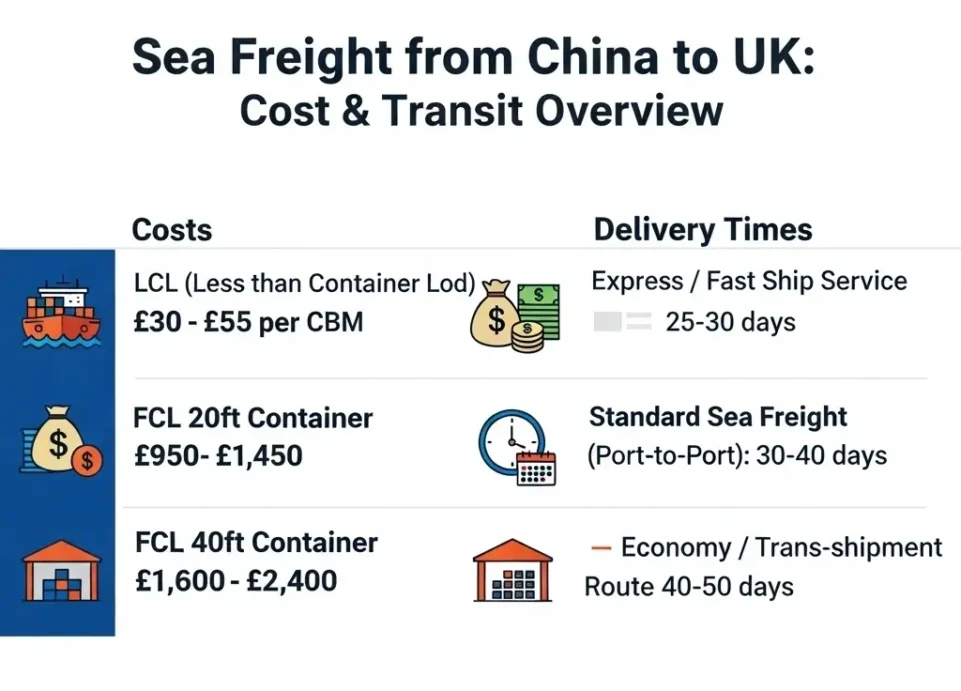
China to UK Sea Freight Shipping Methods Overview
Sea freight from China isn’t just one-size-fits-all; there are different shipping options to match your cargo size, budget, and timeline. Here’s a simple breakdown for shipments from China to the UK:
| Shipping Option | Typical Cost (GBP) | Transit Time | Pros | Cons |
| FCL (Full Container Load) | £950–£1,450 (20ft)£1,600–£2,400 (40ft) | 25–40 days | Fast, secure, low cost per unit for bulk shipments | Requires enough cargo to fill container; higher upfront cost |
| LCL (Less than Container Load) | £30–£55 per CBM | 30–50 days | Cost-effective for smaller shipments, flexible quantity | Slightly longer transit; more handling during consolidation |
| Express / Door-to-Door Sea Freight | Varies; higher than standard LCL/FCL | 25–30 days | Convenient, full tracking, minimal hassle | Slightly higher cost |
| Standard / Economy Sea Freight | £30–£55 per CBM (LCL)£950–£2,400 (FCL) | 30–50 days | Cheapest for bulk shipments | Longer lead time; inland delivery coordination needed |
FCL vs LCL: Choosing the Right Shipping Option
If you’re new to sea freight, you’ll often hear about FCL and LCL. Here’s what they mean in real life:
- FCL (Full Container Load): You rent an entire container (20ft or 40ft). It’s faster, safer, and more cost-efficient if you’re shipping a large volume.
- LCL (Less than Container Load): Your goods share a container with other shipments. It’s cheaper for small or medium batches, but takes a bit longer due to consolidation and deconsolidation at ports.
A simple rule: if your goods fill more than half of a 20ft container, go FCL. Otherwise, LCL is your friend.
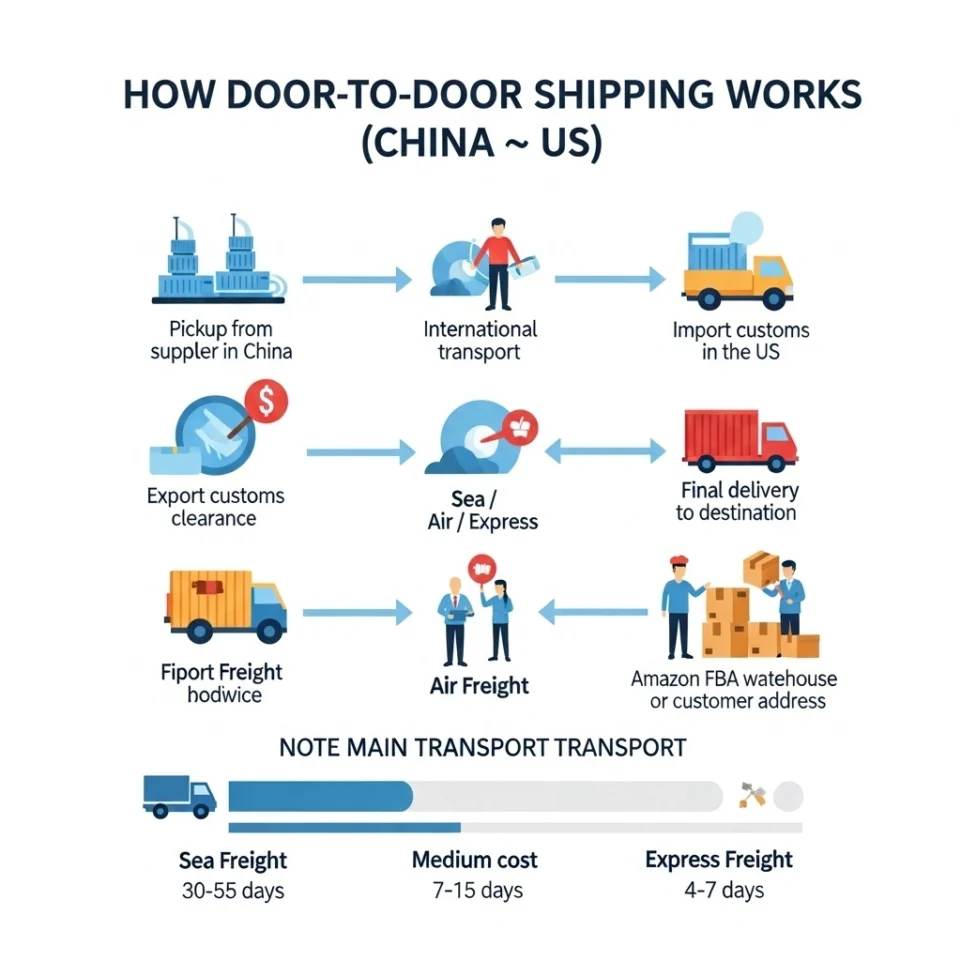
China to UK Sea Freight: Detailed Shipping Cost Insights
Here’s a clear comparison of various shipping methods, so you can pick the right one based on cost, speed and cargo size. For a broader perspective on European routes, you can also refer to our main guide on shipping from China to Europe.
| Feature | Sea Freight (Ocean) | Rail Freight (The New Silk Road) | Air Freight |
| Best For | Large volume, heavy, non-urgent goods (e.g., machinery, furniture, high-volume inventory). | Mid-sized, time-sensitive goods where air is too costly (e.g., electronics, apparel, seasonal stock). | Urgent, high-value, small/lightweight goods (e.g., samples, fashion launches, stockout prevention). |
| Transit Time (Door-to-Door) | 30 – 45 Days | 18 – 25 Days | 3 – 10 Days |
| Cost Efficiency | Lowest (The most cost-effective per unit, especially FCL). | Medium (Cheaper than air, more expensive than sea). | Highest (Most expensive per KG). |
| Capacity | Highest (Handles massive bulk shipments and oversized cargo). | High (Container-based, similar to sea, but less overall capacity). | Low (Restrictions on size and dangerous goods/batteries). |
| Reliability/Risk | Moderate (Most susceptible to port congestion and weather delays). | High (More reliable than sea, less impacted by weather/port issues). | Highest (Fastest and most predictable schedules). |
| TopShipping Service | FCL & LCL options, full DDP, and VAT compliance. | FCL & LCL options to EU hubs, final delivery into the UK by truck. | Standard Air Cargo and Express Courier options available. |
Actual Transit Time for Sea Freight from China to UK
On average, sea freight from China to the UK takes between 30 to 40 days, depending on several factors like your port of origin, route, transshipments, customs clearance, and final delivery location in the UK. Here’s a quick look at typical transit times:
| Stage | Estimated Timeframe | Key Takeaway |
| Ocean Transit | 30 – 40 Days | This is the actual time on the water. |
| Origin Logistics (China) | 3 – 7 Days | Consolidation, Customs Clearance, Port Handling. |
| Destination Logistics (UK) | 3 – 5 Days | Unloading, UK Customs, Final Delivery (drayage). |
| Total Door-to-Door Time | Approx. 40 – 52 Days | Plan your supply chain around a 6-7 week lead time to be safe. |
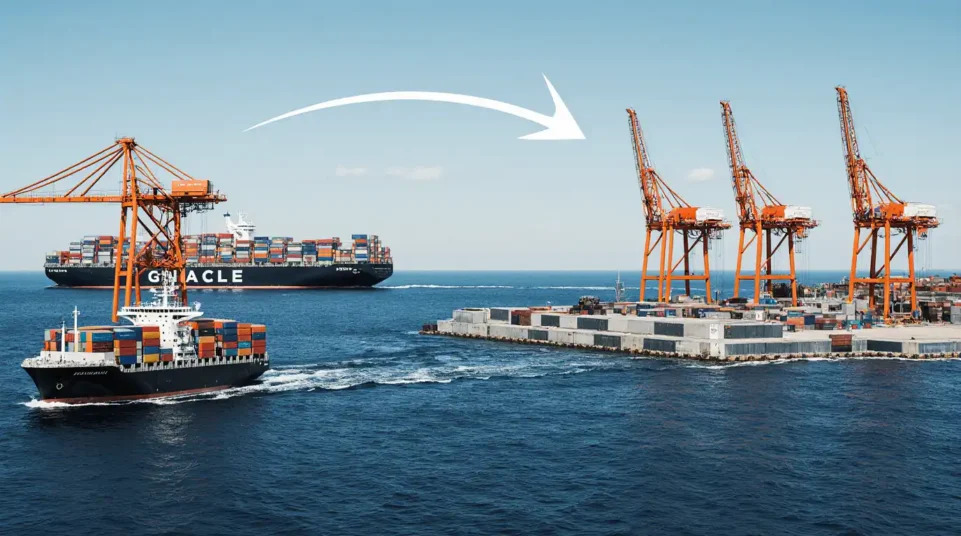
Factors Affecting Sea Freight Time
Several elements can influence how long it takes for your sea shipment to arrive in the UK:
- Route selection: Southern routes via the Suez Canal are usually faster than alternative ones such as around the Cape of Good Hope.
- Port congestion: Busy periods at major ports in China or the UK can delay both loading and unloading by several days.
- Weather conditions: Storms and typhoons, particularly in the South China Sea, can slow vessel schedules or force rerouting.
- Transshipment: Indirect shipping routes that require container transfers at intermediate ports add extra handling time.
- Customs and documentation: Incomplete paperwork or customs clearance issues may hold containers for days at destination ports.
- Shipping season: During peak periods like pre-Christmas or Chinese New Year, high cargo volumes often result in longer waiting times for vessel space and unloading.
The Cost of Sea Freight from China to the UK
If your business deals with large volume, heavy items, or products where per-unit cost is everything (like hardware or bulk retail goods), then the ocean is your financial friend.
Once your shipment volume exceeds about 2 CBM (Cubic Meters), or the weight gets heavy, sea freight becomes vastly more affordable than air freight. This is why our most successful wholesalers rely on FCL and LCL options
For LCL (Less than Container Load) shipments:
Right now, LCL rates from major Chinese ports like Shenzhen, Shanghai, or Ningbo to UK ports range from £40-£80 per CBM, depending on the season and demand.
For FCL (Full Container Load):
If you’ve got enough goods to fill a 20ft or 40ft container, FCL is almost always more cost-effective. Current rates look something like this:
- 20ft container: £1,800 – £2,800
- 40ft container: £2,500 – £4,200
- 40ft High Cube: £2,700 – £4,500
But keep in mind, the “headline price” isn’t the full story. Real shipping costs depend on:
- Container size (FCL vs LCL)
- Port charges and surcharges
- Customs and import duties
- Final delivery distance within the UK
- Peak season rates
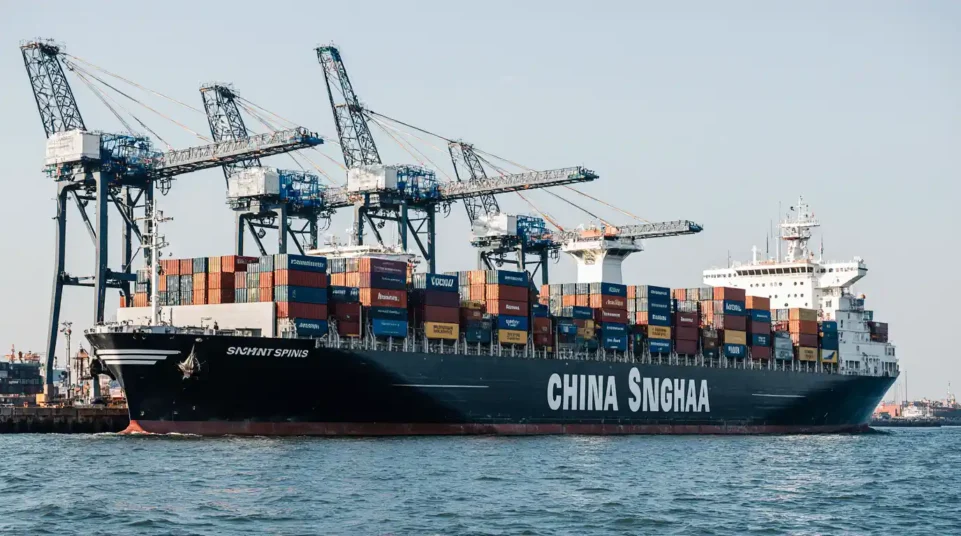
Main Ocean Freight Routes from China to UK Ports
Most sea freight from China to the UK follows one of two main routes:
| Route | Description | Transit Time | Pros | Cons | Main UK Ports |
| Direct via Suez Canal | Container sails from major Chinese ports (Shanghai, Shenzhen, Ningbo, Qingdao) → South China Sea → Indian Ocean → Suez Canal → Mediterranean → UK | Standard, fastest route | Most common; usually fastest | Congestion or delays at Suez possible | Felixstowe, Southampton, London Gateway |
| Alternative via Cape of Good Hope | Container sails around southern tip of Africa instead of Suez Canal | +7–10 days compared to Suez route | Can avoid Suez delays; sometimes cheaper | Longer transit time | Felixstowe, Southampton, London Gateway |
China to UK Shipping: Customs, VAT, Insurance, and Import Duties
Importing goods from China to the UK isn’t just about shipping, there are a few extra costs and legal steps you need to be aware of. Understanding these will save you time, money, and headaches at the port.
| Item | What It Is | Typical Calculation / Notes | Tips for Importers |
| Customs Clearance | The official process of declaring your goods to UK customs and getting permission to release them from the port | Usually handled by your freight forwarder; includes documentation fees | Make sure all invoices and packing lists are accurate to avoid delays |
| Import VAT | Value Added Tax on imported goods | Standard rate: 20% of (Cost of goods + Shipping + Insurance) | Pay upfront or via postponed VAT scheme to manage cash flow |
| Insurance | Protects your cargo against loss, damage, or theft during transport | Usually 0.5–2% of the cargo value depending on coverage | Always insure high-value shipments; can be arranged via your forwarder |
| Customs Duty | Government tax on certain imported goods | Depends on HS Code, value, and origin; some items may be 0% | Check UK Trade Tariff before importing; some goods have preferential rates |
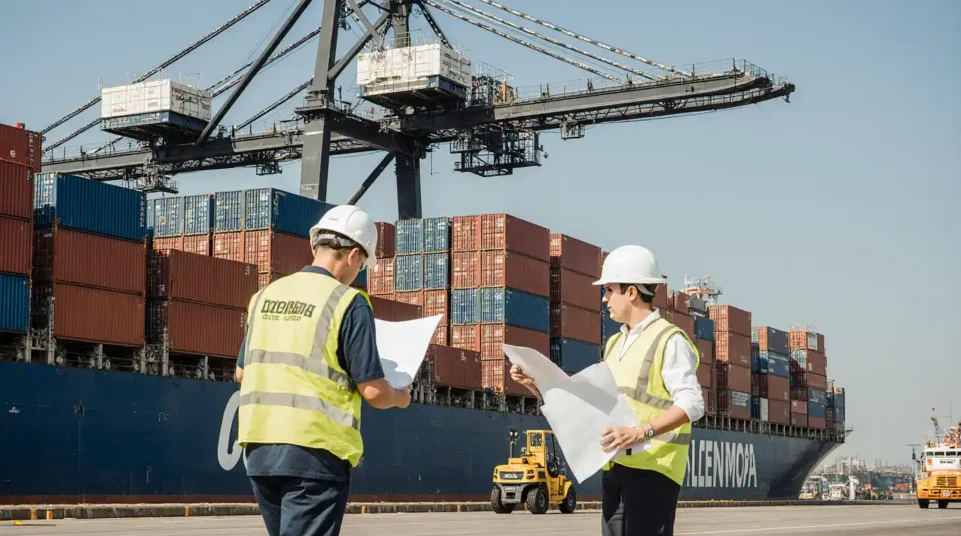
Incoterms Guide for Sea Freight (China to UK)
Choosing the right shipping option isn’t just about container size and cost, it’s also about understanding your responsibilities and costs under different Incoterms. For example:
| Incoterm | Seller Responsibility | Buyer Responsibility | Typical Use Case |
| FOB (Free on Board) | Delivery to the port in China, loading on vessel | Shipping, insurance, import clearance, and inland delivery in UK | Common for FCL and LCL shipments where the buyer wants control over shipping |
| CIF (Cost, Insurance, Freight) | Shipping and insurance to UK port | Import clearance and inland delivery | Useful when buyer wants seller to manage sea transport and insurance |
| DDP (Delivered Duty Paid) | Full responsibility: shipping, insurance, customs duties, and delivery to UK warehouse | Minimal – just receive the goods | Ideal for small businesses or first-time importers who want a hassle-free solution |
Tracking Your Sea Freight Shipment in Real-Time
Remember when shipping felt like sending your cargo into a black hole and just hoping it showed up? Yeah, those days are over.
With TopShipping, you get real-time tracking from the moment your goods leave the Chinese factory until they arrive at your UK address. You’ll know when your container is loaded, when the vessel departs, where it is on the ocean, and when it’s expected to dock in the UK.
We send proactive updates at key milestones, and if there’s any delay (weather, port congestion, customs queries), you hear about it from us first, not three weeks later when you’re wondering where your stock is.
China to UK: Selecting the Best Sea Freight Service Provider
The right sea freight partner can make the difference between a smooth, cost-efficient delivery and an expensive headache. Here’s how to find the most reliable and suitable service for your shipment:
- Compare multiple freight forwarders: Get quotes from several providers to compare not only price but also transit times, customer service, and included services (like customs clearance or door delivery).
- Check experience with China–UK routes: A forwarder familiar with Chinese ports (like Shanghai or Shenzhen) and UK ports (such as Felixstowe or Southampton) can handle route-specific paperwork and port logistics more efficiently.
- Evaluate transparency and communication: Choose companies that offer clear cost breakdowns, real-time tracking systems, and proactive updates throughout the shipment process.
- Ask about insurance and liability coverage: Reliable freight partners will help you secure cargo insurance and clarify who’s responsible if goods are lost or damaged in transit.
- Review customer feedback and reliability: Check reviews, testimonials, and industry reputation to ensure the company delivers shipments safely and on time.
- Look for flexible shipping options: Some forwarders offer LCL (Less than Container Load) or FCL (Full Container Load) options, as well as multimodal combinations like sea + rail, which may fit your timing and budget better.

TopShipping: Reliable Ocean Freight Services from China to UK
Here’s what makes us different and why our clients stick with us shipment after shipment. We’re based in Shenzhen, right in the heart of China’s manufacturing region. That means we can coordinate factory pickups, handle consolidation from multiple suppliers, inspect your goods before they ship, and negotiate better rates because we’re local, not remote.
But we also have a European presence (our Luxembourg office), so we understand the UK market, post-Brexit regulations, and what your business actually needs to succeed.
You get:
- Transparent pricing with no hidden fees
- Real people who speak English, French, and Chinese
- Factory inspections and quality checks (free for large orders)
- Full customs support and DDP options
- Fast quote turnaround usually within hours, not days
- Technology that tracks everything but humans who actually care
We work with UK businesses of all sizes from Amazon sellers shipping their first container to established wholesalers importing multiple containers per month. And honestly? Some of our best relationships started with someone who was frustrated with their previous forwarder and just wanted straight answers and reliable service.
FAQ: Sea Freight from China to UK
How much is sea freight from China to the UK?
The cost depends mainly on the volume of your goods and the service you choose (FCL or LCL).
- LCL (Less than Container Load): You pay per cubic meter (CBM). Prices typically range from $80 to $150 per CBM for the base ocean freight, plus origin/destination fees and local charges. This is the cheapest method for smaller commercial shipments (under 15-20 CBM).
- FCL (Full Container Load): You pay a fixed price for the entire container. Rates fluctuate wildly with the market, but general base freight costs can range from $2,000 – $4,000 for a 20-foot container and $3,000 – $5,500 for a 40-foot container.
How much does it cost to ship a 40ft container from China to UK?
For a 40-foot container (which holds around 67 CBM), the base ocean freight from a major Chinese port (like Shanghai or Shenzhen) to a UK port (like Felixstowe or Southampton) typically starts around $3,000 to $5,500 USD.
However, the final door-to-door cost, including all terminal handling, documentation, UK customs clearance, and inland trucking, will typically be significantly higher and is best provided via a tailored quote. Container rates are highly volatile and change weekly.
How long does sea freight take from China to UK?
You should budget a total of 30 to 45 days for the full door-to-door process. This breaks down roughly as:
- Origin Logistics (Pickup/Loading): 3-7 days
- Vessel Voyage (Port-to-Port): 26-35 days
- Destination Logistics (Customs/Delivery): 3-7 days
How long does it take for a boat to go from China to the UK?
The actual sailing time (port-to-port voyage) for a cargo vessel from major Chinese ports (like Yantian/Shenzhen or Shanghai) to major UK ports (like Felixstowe or Southampton) is typically 26 to 35 days. This route usually involves transit through the Suez Canal.
Can I track my sea freight from China to UK?
Absolutely. Once your shipment is loaded and departs, you will receive either a Bill of Lading (B/L) number for LCL shipments or a container number for FCL shipments. We provide you with access to our platform where you can track the vessel’s major milestones (departure, transshipment stops, arrival at the UK port) in near real-time, just like tracking a large parcel.
What shipping routes do vessels take from China to UK?
The main route for commercial cargo ships from China to the UK (and Northern Europe) is the Suez Canal Route.
- Vessels depart major Chinese ports (e.g., Shanghai, Ningbo, Shenzhen/Yantian).
- They sail through the Strait of Malacca.
- They cross the Indian Ocean and transit the Suez Canal.
- They sail through the Mediterranean Sea and the Strait of Gibraltar.
- Finally, they cross the Bay of Biscay to reach UK ports like Felixstowe, Southampton, or London Gateway.
Some experimental services have recently tested the Arctic Route (Northeast Passage), which is faster but highly seasonal and dependent on ice conditions.
What’s the difference between shipping from China to UK by sea versus by air?
| Feature | Sea Freight | Air Freight |
| Primary Advantage | Cost-effectiveness for large volume/heavy goods. | Speed for urgent, small, or high-value items. |
| Transit Time | 30 – 45 days (Door-to-Door) | 5 – 8 days (Door-to-Door) |
| Cost | Much Lower per KG/CBM | Much Higher per KG |
| Ideal Cargo | Over 2 CBM; low-value, high-volume products. | Under 1 CBM; high-value, time-critical products. |

